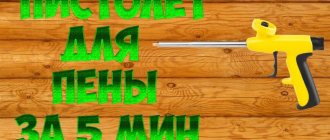Rules for using foam
There are a number of rules for using polyurethane foam. First of all, you need to take care of the surface on which the material will be applied. If there are any oil stains, peeling plaster or paint, they should be removed.
The surface must be cleaned and wet. Then apply it in an even layer and wait until it dries completely according to the instructions. The finished material can be cut, plastered, wallpapered and puttyed.
Since the foam is not resistant to direct ultraviolet rays, the finished surface will need to be puttied, thereby closing it from direct access. There are also special tapes on sale that protect it from exposure to rays.
It is very important to observe the maximum diameter; it should be no more than three centimeters. In the case of a wide gap or hole, it is necessary to apply foam in several layers.
It is important not only to let each layer dry, but also to remember to moisten the surface on which the material is applied before use.
In addition, you should not touch the foam after application, since the impact inhibits the natural chemical hardening process. As a result, the volume, as well as the density of the substance, will be completely different.
In addition, you must shake the can thoroughly before use. It is better to place it upside down so that the substance that forms the foam comes out first, and at the very end - the compressed gas, and not vice versa.
In addition, work must begin from the bottom, slowly rising in a v-shaped motion to the top, and not vice versa.
It is very important to observe at least basic precautions when working with this substance. Because foam that has not yet hardened causes acute irritation of the skin, mucous membranes and respiratory tract. If it gets on clothing, it is removed with acetone.
Manufacturing examples with instructions
There are a large number of examples of making figures from polyurethane foam. They vary in shape, size, and color characteristics. Used only for holidays or everyday.
Christmas tree
At the first stage of making a Christmas tree from polyurethane foam with your own hands, you need to prepare the frame. To do this, three triangles are cut out of cardboard (you can use material from a regular box).
If you need a tall Christmas tree, then the triangles should be narrower and higher; if the Christmas tree is small, then lower and wider.
Then the prepared three cardboard sides are connected with tape. Place a cardboard board under the workpiece, which will help avoid contamination of the table surface.
At the second stage, polyurethane foam is applied. To do this, the container is thoroughly shaken and layer-by-layer application begins on each side from the bottom.
The foamed product is left to dry for a day. Then, using various tinsel, the Christmas tree is decorated.
We recommend watching the video instructions:
Photo of polyurethane foam
Did you like the article?
0
Foam insulation - definition and characteristics?
We will try to consider in detail the features of this material and its application, so that everyone who builds their own house can master working with it. It is now not only fashionable, but also necessary to warm yourself. Energy prices are inexorably creeping up, maintaining comfort in the house is becoming an increasingly wasteful activity, so insulating apartments is more important than ever. The same wave has also swept over the construction of houses, where you can acquire a “reliable fur coat” at a very early stage; all that remains is to decide on its type. But if you have a ready-made building, even with finishing, insulation will not be a problem, especially when it was decided to use foam insulation.
The class of these substances is a polymer or a combination thereof; upon reaction between the components or a single component with moisture and air, curing occurs with pre-foaming, due to which the material successfully fills the space, sometimes increasing in volume by 20 times. The disadvantages of this group of insulation are the need for good air flow, that is, ventilation of the room for work. You also need to properly protect the insulation layer after finishing the work, because it is afraid of sunlight and precipitation; over time, the material will simply begin to deteriorate.
But these points cannot overshadow the impression of the advantages of foam materials. Biological and environmental safety allow their use in residential premises of varying degrees of cleanliness. Such insulation consists of pores filled with air or a gaseous reaction product between the components, due to this, good thermal and waterproofing is created, so additional measures to protect the room from freezing and moisture are not required. But this is provided that all external pores of the material are insulated with finishing (internal or external, depending on the location of the insulation).
Foam insulation that is well sealed from external influences will serve you for an incomparably long time, moreover, over a wide range of temperatures, even the coldest Russian winters will not destroy the material, the same applies to elemental heat.
Good insulation is also due to the fact that, when expanding, the foam does not form seams or gaps through which cold could still seep, so the “fur coat” of these materials is the most reliable. They also adhere well to any coating; adhesion guarantees reliable service for many years. This layer also has antiseptic properties and protects the metal from corrosion. Yes, also, the material, as a rule, is not flammable, you see, that’s also a plus.
Selection rules
When choosing a material, you should pay attention to important nuances:
- Foam output . Although most containers are the same size, the amount of foam inside may vary. Usually the actual volume is 10-15 ml less than indicated. When purchasing, you need to take into account that 750 ml of foam weighs 900 g. If the mass of the cylinder is less, then it is better to choose another option.
- Cylinder volume . Standard values are 300 ml, 500 ml and 750 ml. The choice should be based on the amount of work to be carried out.
- Secondary expansion . This indicator is very important for working with windows. If the variety has a high rate of secondary expansion, then it is not suitable for installing window sills. As the volume increases, the parts will rise significantly.
- Brand . It is best to give preference to well-known manufacturers who have proven themselves to be of decent quality.
- Best before date . Most often it is 18 months. You should only purchase fresh products.
- Appearance of the cylinder . There should be no dents or chips on it.
Any brand of foam is suitable for working with windows. But it is necessary to compare the technical characteristics of the material with the conditions of its use.
Terms of Use
Before starting work, you must familiarize yourself with the operating temperature range of a particular type of material .
The process of its hardening directly depends on air humidity. It is different at different temperatures. For example, if the air temperature is -10°C, then one cubic meter of air contains only 3 g of water. When the mark rises to +25°C, the amount of moisture in 1 cubic meter. increases to 20 g.
Moisture deficiency leads to slow hardening of the foam and disruption of the structure . Therefore, you need to use the substance only in the temperature range recommended for a particular type of foam.











